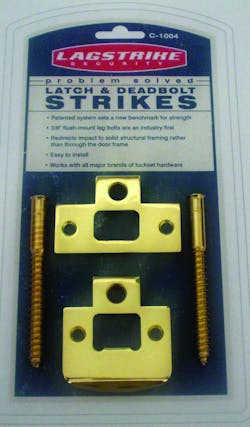Five years ago an enterprising couple in Oregon owned a group of rental properties. One of their recurring problems with the rental properties was damaged door frames caused either by tenants, vandals or normal wear and tear. After replacing several door frames, the owners and co-inventors decided there must be a more secure system and the Lagstrike idea was born.
It is no secret that the weakest link in a residential locking system is the door jamb. Interior stud framework surrounding the door jamb is designed to be supportive and substantial. A gap usually exists between the thin door jamb material and the internal studs. This allows a few well-placed shims to be inserted between the jamb and studs so the jamb can form a uniform, decorative opening around the door.
In spite of known weaknesses in thin door jambs, many lock manufacturers continue to furnish short 3/4” strike plate screws for cylindrical locksets and depend entirely on the decorative door jamb for securing the strike plate. Even if longer screws are originally furnished, the fastening area is not centrally located within the door jamb so the screws fasten into weaker material near the edge of interior studs.
First Security immediately decided that in order to be more secure, the strike plate must somehow be fastened to the inner structure and connected near the center of the interior studs. The Lagstrike invention consists of adding a tab, (called a security member), to a standard strike plate profile. The security member extends towards the center of the door jamb. The security member is folded over to form a dual surface for added strength. A hole in the security member is designed to accept a special 3/8” X 3 3/4” security anchor. The hexhead anchor passes through the security member and normal thin door jamb material, and then solidly fastens the strike plate into the interior stud framework.
Inventing the product was the easy part. A provisional patent was applied for and First Security displayed their new security strike plate at ISC West in Las, Vegas. First Security reports that the response was overwhelming from attending locksmiths, security professionals and government representatives.
Unfortunately they learned that obtaining a patent takes time. They also learned that their manufacturing capability could not meet the order demands for their product. After two years of waiting, the patent was finally issued on July 8, 2008. Currently First Security has secured a competent manufacturer and product is ready for shipping.
INSTALLING LAGSTRIKE
1. Remove weather stripping on strike plate side of door jamb.
2. Place the Lagstrike over the existing strike plate and outline the position of the security member using a pencil.
3. Use a wood chisel to remove enough jamb surface material to allow the Lagstrike to fit flush with the surface.
4. Secure Lagstrike to jamb using two 3/4” screws.
5. Use hole in Lagstrike security member as a template to drill a 5/16” diameter hole to a maximum depth of 3 3/4”.
6. Install security anchor using a 3/16” Allen head tool.
7. Reinstall weather stripping.
Lagstrike security strikes are available for either cylindrical locksets or cylindrical deadbolts or as a system for doors having a deadbolt and a knob lock. . Lagstrikes are available in finishes to match existing decor. They can be quickly and easily installed and can add an extra amount of profit on every service call.
For further information, contact First Security LLC, telephone 888-442-4494 or web site www.lagstrikesecurity.com






